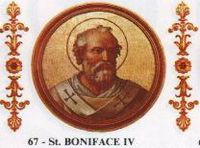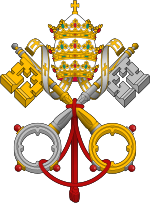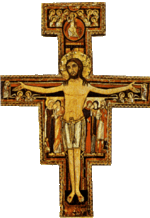Pope Boniface IV
| Boniface IV | |
|---|---|
 |
|
| Papacy began | September 15, 608 |
| Papacy ended | May 25, 615 |
| Predecessor | Boniface III |
| Successor | Adeodatus I |
| Personal details | |
| Birth name | ??? |
| Born | c. 550 Valeria, Eastern Roman Empire |
| Died | May 25, 615 Rome, Byzantine Empire |
| Other Popes named Boniface | |
| Papal styles of Pope Boniface IV |
|
|---|---|
 |
|
| Reference style | His Holiness |
| Spoken style | Your Holiness |
| Religious style | Holy Father |
| Posthumous style | Saint |
Pope Saint Boniface IV (c. 550 – May 25, 615) was pope from 608 to his death.
Son of Johannes, a physician, a Marsian from the province and town of Valeria; he succeeded Boniface III after a vacancy of over nine months. He was consecrated on either 25 August (Duchesne) or September 15 (Jaffé) in 608. His death is listed as either May 8 or May 25, 615 by these two authorities.
In the time of Pope Gregory I, he was a deacon of the Roman Church and held the position of dispensator, that is, the first official in connection with the administration of the patrimonies.
Boniface obtained leave from the Emperor Phocas to convert the Pantheon, Rome into a Christian church, and on May 13, 609 (?) the temple erected by Agrippa to Jupiter the Avenger, to Venus, and to Mars was consecrated by the pope to the Virgin Mary and all the Martyrs. It was the first instance at Rome of the transformation of a pagan temple into a place of Christian worship. Twenty-eight cartloads of sacred bones were said to have been removed from the Catacombs and placed in a porphyry basin beneath the high altar.
During the pontificate of Boniface, Mellitus, the first Bishop of London, went to Rome "to consult the pope on important matters relative to the newly established English Church".[1] While in Rome he assisted at a council then being held concerning certain questions on "the life and monastic peace of monks", and, on his departure, took with him to England the decree of the council together with letters from the pope to Lawrence, Archbishop of Canterbury, and to all the clergy, to King Ethelbert, and to all the English people "concerning what was to be observed by the Church of England". The decrees of the council now extant are spurious. The letter to Ethelbert[2] is considered spurious by Hefele,[3] questionable by Haddan and Stubbs,[4] and genuine by Jaffé.[5]
Between 612 and 615, the Irish missionary Saint Columban, then living at Bobbio in Italy, was persuaded by Agilulf, King of the Lombards, to address a letter on the condemnation of the "Three Chapters" to Boniface IV. "You have already erred, O Rome! — fatally, foully erred. No longer do you shine as a star in the apostolic firmament," Columban wrote. He also tells the pope that he is charged with heresy for accepting the Fifth Ecumenical Council (the Second Council of Constantinople in 553), and exhorts him to summon a council and prove his orthodoxy.[6]
Boniface had converted his own house into a monastery, where he retired and died. He was buried in the portico of St. Peter's Basilica. His remains were three times removed — in the tenth or eleventh century, at the close of the thirteenth under Boniface VIII, and to the new St. Peter's on 21 October 1603.
Boniface IV is commemorated as a saint in the Roman Martyrology on his feast day, May 25.
References
- Bede. Historia ecclesiastica gentis Anglorum
- Gasquet, Francis Aidan. A Short History of the Catholic Church in England, 19
- Gregorovius, Ferdinand. II, 104
- Hunt, William. The English Church from Its Foundation to the Norman Conquest. Vol. 1. "A History of the English Church", W. R. W. Stephens and William Hunt, ed. London: Macmillan and Co., 1901. 42
- Jaffé, Regesta Pontificum Romanorum ab condita ecclesia ad annum 1198. Berlin, 1851; 2d ed., Leipsic, 1881–88. I, 220
- Joseph Langen, Geschichte der Römischen Kirche, 501
- Liber Pontificalis (ed. Duchesne), I, 317
- Mann, Horace K. Lives of the Popes I, 268–279
- Mansi, Gian Domenico. X, 501
- Paul the Deacon, History of the Longobards, IV, 36 (37)
Notes
- ↑ Bede, H. E., II, iv.
- ↑ In William of Malmesbury, De Gest. Pont., I, 1464, ed. Migne.
- ↑ Conciliengeschichte, III, 66.
- ↑ Councils, III, 65.
- ↑ Regest. RR. PP., 1988 (1548).
- ↑ Catholic Encyclopedia. New York: Robert Appleton Company. 1913. http://www.newadvent.org/cathen/02660c.htm.
![]() This article incorporates text from a publication now in the public domain: Herbermann, Charles, ed (1913). Catholic Encyclopedia. Robert Appleton Company.
This article incorporates text from a publication now in the public domain: Herbermann, Charles, ed (1913). Catholic Encyclopedia. Robert Appleton Company.
External links
- Catholic Encyclopedia. New York: Robert Appleton Company. 1913. http://www.newadvent.org/cathen/02660c.htm.
- Biography from CFPeople.org
| Catholic Church titles | ||
|---|---|---|
| Preceded by Boniface III |
Pope 608–615 |
Succeeded by Adeodatus I |
|
|||||||||||||||||||||||||||||||||||||||||||||
|
|||||||||||||||||||||||||||||||||||||||||

